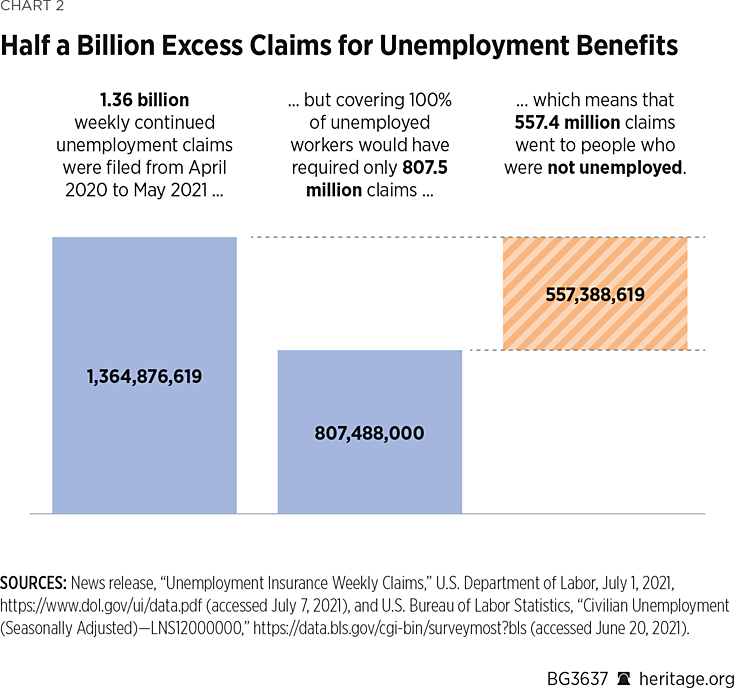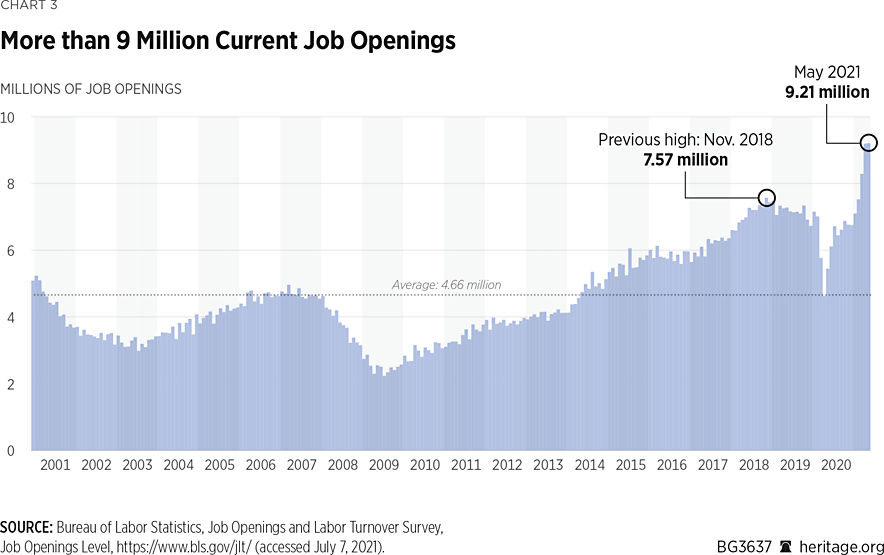The massively expanded unemployment insurance (UI) benefits have, arguably, turned out to be the most flawed, wasteful, and, in many instances, damaging component of the federal government’s COVID-19 economic policy response. Yet many of these expanded benefits remain in place today, 16 months after the start of the pandemic, with high vaccination rates, dropping infection numbers, and a record-high number of job openings.
The expansion of benefits to workers who do not contribute to UI systems, the lack of proper eligibility verifications, and the unprecedented size of unemployment checks—often exceeding $1,000 per week—caused a surge in unemployment benefits never before seen in this country, and far beyond policymakers’ intent. Throughout the pandemic, far more people received UI benefits than were actually unemployed.REF Historically, about 40 percent of unemployed workers received unemployment benefits, but, since Congress expanded benefits during the COVID-19 pandemic, unemployment benefits have equated to 176 percent of unemployed workers. These programs have resulted in an estimated $357 billion of Americans’ tax dollars being used to send unemployment benefits to people who were not unemployed, caused the identity theft of hundreds of thousands—if not millions—of people, and recently contributed to an unprecedented labor shortage that is holding back America’s recovery.
Some policymakers want to perpetuate these problematic programs through new and expanded UI programs and federal mandates on states. The systematic failures, widespread fraud, and unintended economic effects of these programs should serve as a warning sign—not a blueprint—to policymakers considering permanent UI expansions.
Unemployment Insurance, Pre-Pandemic and Post-Pandemic
UI in the United States is largely a state-based system with minimal federal requirements. The intent of UI is to provide temporary financial help to individuals who were laid off while they find new employment. To qualify for benefits, workers must have been in covered employment (meaning that they worked for a traditional employer who paid into the UI system on their behalf), must have been consistently employed for a specified number of months, and typically must have been laid off through no fault of their own (as opposed to quitting or being fired). States typically provide benefits that replace about 40 percent to 50 percent of workers’ previous earnings, for an average of up to 26 weeks.
During recessions, the federal government has often supplemented state unemployment benefits by paying for extended weeks of eligibility, providing as much as 99 weeks of benefits during the Great Recession of 2008 and 2009.
In response to the COVID-19 pandemic, federal policymakers enacted unprecedented expansions to UI systems, including:REF
Expanded coverage. Congress established the Pandemic Unemployment Assistance program to provide benefits to workers (such as the self-employed and gig workers) who do not pay into the UI system, as well as to workers who otherwise lacked eligibility (such as not having been regularly employed).
Increased benefit levels. Congress provided an unprecedented $600 weekly supplement to state UI benefits from March 2020 through July 2020, and an additional $300 weekly supplement from December 2020 through September 2021. Congress also added an additional $100 per week on top of other unemployment benefits, available from December 2020 through September 2021, to “mixed earners,” who had at least $5,000 of self-employment income in the prior year.
Extended benefits. Congress extended eligibility for UI benefits from the usual 26-week limit (six months) to 79 weeks (18 months).
Loosened eligibility. Congress significantly expanded the criteria for collecting UI benefits through its pandemic program, including reasons other than being laid off through no fault of one’s own. Some of these additional qualifications included losing partial income, being “impacted” by school or daycare closures, quitting one’s job for reasons related to COVID-19, or the very broad qualification of one’s employment being “affected” by COVID-19.
Unemployment Benefits Far Exceed Unemployed Workers
The result of these unprecedented expansions in UI benefits has been a surge in unemployment-benefit claims and payouts far beyond policymakers’ intent. Typically, about 40 percent of unemployed workers receive UI benefits.REF Since the pandemic began, far more people have received unemployment benefits than have actually been unemployed. Between April 2020 and May 2021, the number of people receiving unemployment benefits averaged 176 percent of the number of unemployed people.REF

Between April 2020 and May 2021, the number of continued claims that were processed and paid out totaled 1.365 billion cumulative weeks of benefits. Had the pandemic programs provided unemployment benefits to 100 percent of all unemployed workers, the cumulative number of benefit checks sent out would have been 807 million, which implies that at least 557 millionREF benefit checks went to people who were not actually unemployed.REF The number of unemployment benefits sent out above and beyond 100 percent of unemployed workers equals about 41 percent of all benefits. Assuming there was no significant difference in the size of benefit claims that went to unemployed workers verses those to people other than unemployed workers, then $357 billionREF of the estimated $873 billionREF in total pandemic UI benefits did not actually go to unemployed workers.REF While some states have successfully recovered hundreds of millions of dollars in fraudulent payments, total recoveries are unfortunately only on the magnitude of a few billion dollars nationally.REF

The intent of UI expansions was to provide temporary financial support to tens of millions of workers who lost their jobs or the ability to work through no fault of their own. Due to the tremendous increase in the size and duration of benefits, the easing of verification requirements, and the extension of benefit eligibility to independent workers, the UI programs suffered significant unintended consequences, including widespread fraud, identity theft, and misuse.
Widespread Fraud, Identity Theft, and Misuse
According to the Office of Inspector General (OIG),
The unprecedented infusion of federal funds into the UI program gave individuals and organized criminal groups a high-value target to exploit. That, combined with easily attainable stolen personally identifiable information and continuing UI program weaknesses identified by the OIG over the last several years, allowed criminals to defraud the system.11
The OIG noted that, had improper payments throughout the pandemic remained at their usual pre-pandemic 10 percent rate, the federal government would have issued $87 billion in improper payments. (The OIG estimates up to $873 billion in total pandemic UI benefits.)REF The Inspector General report notes, however, that ongoing investigations find that the improper payment rate exceeds 10 percent.REF
Some researchers have estimated improper payment rates approaching 50 percent within the pandemic UI programs. For example, Blake Hall, CEO of the authentication company ID.me, said, “[t]he fraud rates that we’re seeing are over 10 times what we usually see at federal agencies.”REF Hall, whose company works with about two dozen states to detect fraudulent benefit claims, estimates that unemployment fraud has potentially cost taxpayers $400 billion. The analysis in this Backgrounder above estimates $357 billion worth of payments going to non-unemployed individuals.
UI fraud has been so high that the OIG is investigating or reviewing more than 100,000 complaints of fraud, and these UI fraud investigations account for 87 percent of the Inspector General’s cases, compared to 12 percent prior to the pandemic.REF
In addition to the cost to taxpayers—which, at the above analysis of $357 billion going to non-unemployed people would consume the entire annual wages of 6.9 million median workers—unemployment expansions have also caused a personal-identity-theft assault on hundreds of thousands—if not millions—of Americans.
Among the identity-theft reports filed with the Federal Trade Commission in 2020, 394,000 came from individuals who said their personal information had been used to claim a government benefit.REF This marked a nearly 300-fold increase from about 13,000 such reports in 2019.REF
While states have undertaken efforts to detect and prevent fraud, some states’ actions may have fueled fraud. According to the Los Angeles Times, though the California state auditor recommended in March 2019 that the Employment Development Department (EDD) stop including Social Security numbers in its mailed documents, the EDD continued to send out 38 million pieces of mail containing Social Security numbers after the onset of the pandemic.REF Of the California EDD’s estimated 10 percent to 27 percent of fraudulent benefits paid out,REF 35,000 were issued to names of California prison inmates.REF
In addition to outright criminal activity through stolen identities, there has almost certainly been a high level of individual misuse, abuse, and fraud. Factors such as self-reported verification of eligibility standards allowed people to lie about whether they were working, to falsify how much income they were receiving prior to the pandemic, and to hide income they earned while receiving unemployment benefits.
Moreover, the generous benefits and easy eligibility undoubtedly caused workers to choose unemployment benefits over work. Never before has America experienced relatively high unemployment alongside a record number of job openings, a record-high quits rate, and a record-low number of layoffs.REF

Caution Against Permanent Unemployment Insurance Expansions
Both prior to and since the pandemic, policymakers have introduced proposals to expand the federal government’s role in UI,REF including:
- Mandating that states provide at least 26 weeks of benefits, cover at least 75 percent of a typical worker’s prior wages, cover part-time workers and those who quit their jobs with good cause, and eliminate one-week waiting periods;
- Establishing programs to cover independent workers, such as the self-employed, freelancers, contractors, and gig-workers;
- Expanding the current federal program to kick in automatically as a supplement based on economic conditions, and to provide 100 percent benefit replacement during major disasters or public health emergencies;
- Establishing a $250 weekly Job Seeker’s Allowance available to any unemployed workers not covered by the traditional UI system, such as self-employed workers and new entrants into the labor force; and
- Creating a $25 weekly allowance per dependent of unemployed workers.
While the intent of these proposals is to increase workers’ incomes during periods of unemployment, such policies will inevitably result in unintended consequences, increase administrative costs and total unemployment insurance payouts, and ultimately be paid for by workers through higher UI taxes and reduced compensation.
For starters, economic studies consistently show that higher benefit levels and longer durations lead to higher levels of claims and longer periods of unemployment. For example, researchers at the Federal Reserve Bank of New York estimated that the extended unemployment benefits during the Great Recession contributed significantly to the long period of high unemployment, increasing the number of unemployed workers by about 4.6 million in 2010 and by 3.3 million in 2011.REF Although well-intentioned, automatic increases in benefits based on economic conditions would likely prove self-defeating to the goal of economic recovery, as they would elevate unemployment levels and prolong unemployment durations.
UI programs are effectively a means of forced savings, but with rigid rules and a bureaucratic process required to access the savings. Although employers pay the tax to finance unemployment programs, workers ultimately bear the cost of employment-based taxes through lower wages and benefits. This would cause workers to pay both for the direct expansion in benefits (such as larger unemployment checks and longer durations) and for the resulting increase in unemployment caused by those expansions.
Extending benefits to independent workers would be far more complicated and problematic than the existing unemployment insurance programs because these workers are their own bosses. The problems with insuring independent workers include difficulties with verifying past income, the lack of an employer to verify the reason for a claim (it would be hard to distinguish between workers who lost work through no fault of their own and those who wanted to take a month off), and administrative complications, such as the enforcement of a new unemployment insurance tax on millions of independent workers who have variable income and employment.
Moreover, UI would be of little or no advantage to independent workers when compared to traditional savings. If workers were to make claims for UI benefits, they would face steep UI tax rates in the future. Furthermore, while it is common for independent workers to have swings in their income levels, it is less common for them to suddenly lose all income, which is the shock that traditional UI programs seek to prevent.
Universal Savings Accounts: Helping to Prepare Workers for the Unexpected
The pandemic revealed that many Americans lack the savings they need to weather unexpected life events and loss of income. Instead of mandating new forms of forced savings through UI expansions, policymakers should make it easier for workers to save. While Americans have many options to save for expected life events, such as college, retirement, and health care, it is harder and less advantageous to save for unexpected events, such as losing a job, a car breaking down, or needing to take family or medical leave.
Policymakers should establish universal savings accounts (USAs) so that all Americans can save and invest in a single, simple, and flexible account for any purpose, with no minimum contribution required, and without having to pay penalties or additional taxes upon withdrawal.REF While not having enough money to save is a clear barrier to savings, a potentially equal or larger barrier can be the fear of not being able to access savings or having to pay early withdrawal penalties if workers and families need their savings for an unexpected expense. Thus, USAs have been particularly helpful to lower-income and moderate-income households in Canada and the United Kingdom, for instance, where a majority of account holders are lower-income.REF
Conclusion
The pandemic UI expansions were plagued from the start, beginning with widely available and super-sized $600 weekly bonuses and expansions that made preventing fraud and abuse difficult, leading to criminals taking advantage of easy access to large benefits and stealing peoples’ identities, and an unprecedented labor shortage in the U.S.
Unemployment benefits should not exceed unemployed workers. The fact that 41 percent of unemployment benefits have exceeded the number of unemployed workers is evidence of the inability of government-unemployment-program expansions to achieve their goals. The widespread criminal activity and abuse of the pandemic UI programs have cost taxpayers an estimated $357 billion in fraudulent benefits and resulted in the identity theft of hundreds of thousands—if not millions—of Americans. Moreover, the expansion in benefits has undoubtedly contributed to an unprecedented labor shortage that is holding back America’s recovery. This experience provides a blueprint for what not to do with UI programs.
Policymakers should end the pandemic UI programs immediately. Instead of enacting further problematic and bureaucratic forced-savings programs under the guise of UI, policymakers should establish USAs to make it easier for Americans to save in a single, simple, and flexible account that they can access without limit or bureaucratic approval, to pay for all types of expected and unexpected life events.
Rachel Greszler is Research Fellow in Economics, Budget, and Entitlements in the Grover M. Hermann Center for the Federal Budget, of the Institute for Economic Freedom, at The Heritage Foundation. Morgan Baker is a member of the Young Leaders Program.



